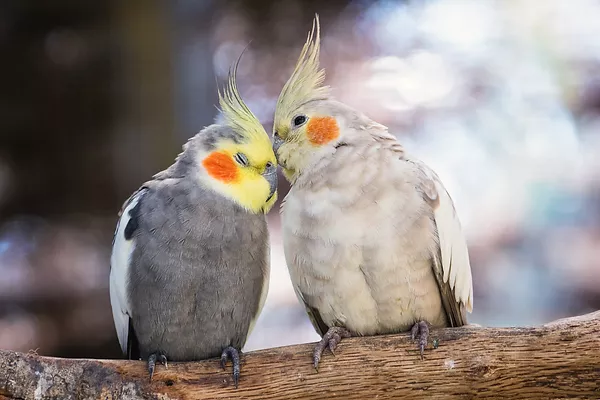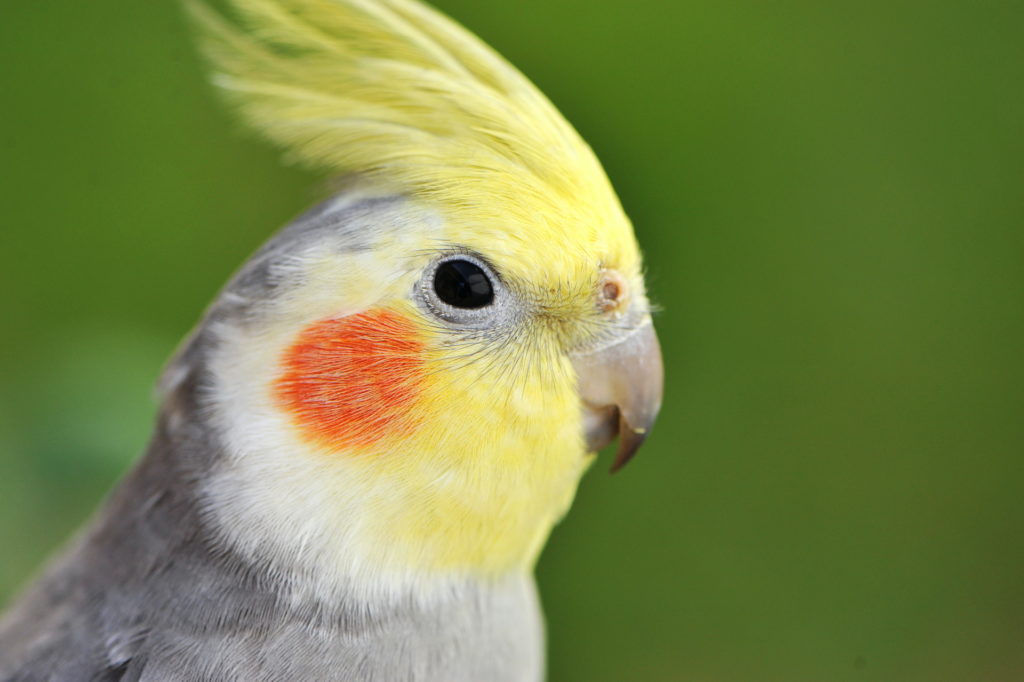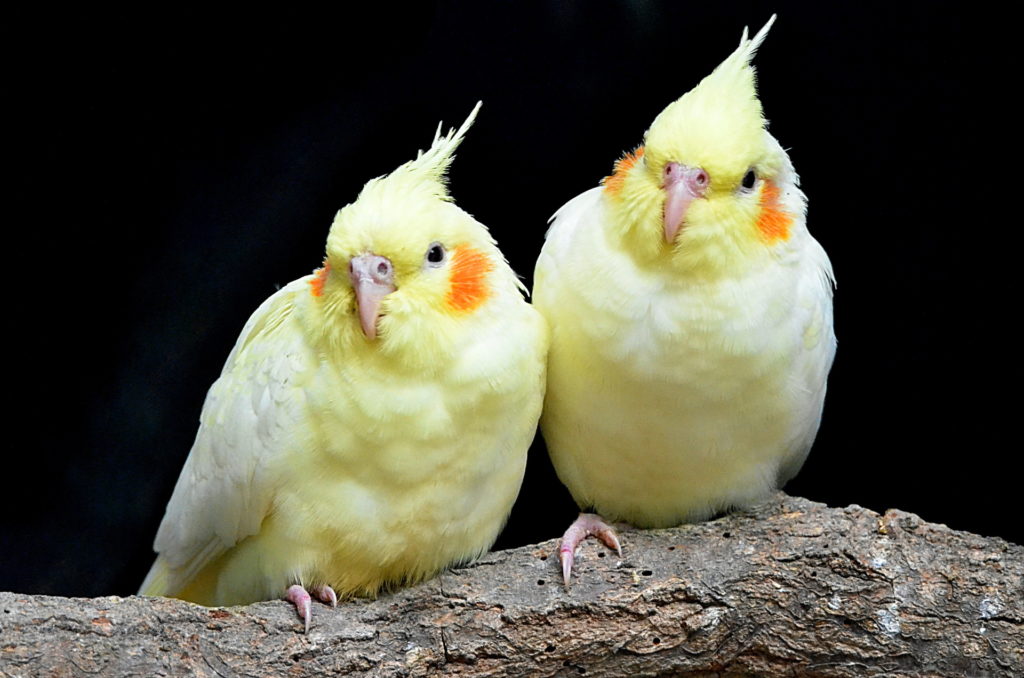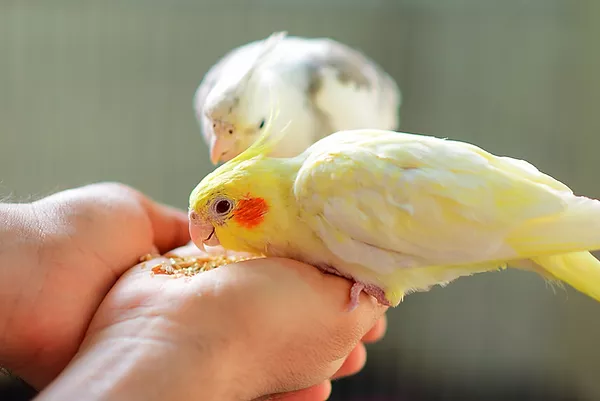Cockatiel Care
Cockatiels are great little Aussie birds with outgoing temperaments that do really well as companion parrots. They are also called quarrions or weiros. Wild cockatiels are found in inland areas of Australia. They have been bred in a large variety of colour mutations such as pied, pearl, lutino, cinnamon, fallow, whiteface and a combination or these! www.cockatielsociety.org.au
What should I feed my bird?
The best diet for a cockatiel is a combination of a formulated small parrot diet supplemented with vegetables, herbs, seeding grasses and native foliage. Treats such as millet spray, fresh and dried fruit and sunflower seed can be used as a reward during training sessions or playtime.
Parrot pellets are low in fat and contain all the vitamins and minerals your bird needs. Vetafarm finch and budgie crumble, parrot maintenance or nutriblend pellets are good choices. www.vetafarm.com.au
Vegetables such as spinach, asian greens, beans, broccoli, corn, peas, carrot and herbs such as mint, basil, parsley and rocket are all safe for your bird to eat. Avocado and rhubarb leaves are toxic. Australian native flowers such as banksia, bottlebrush, grevillea and eucalyptus flowers can be great toys and a supplement to your bird’s diet. Seeding grasses should be collected from areas that are free from chemical sprays. Sprouted seed is readily enjoyed and lower in fat than dry seeds such as sunflower seed.
Parrot pellets are low in fat and contain all the vitamins and minerals your bird needs. Vetafarm finch and budgie crumble, parrot maintenance or nutriblend pellets are good choices. www.vetafarm.com.au
Vegetables such as spinach, asian greens, beans, broccoli, corn, peas, carrot and herbs such as mint, basil, parsley and rocket are all safe for your bird to eat. Avocado and rhubarb leaves are toxic. Australian native flowers such as banksia, bottlebrush, grevillea and eucalyptus flowers can be great toys and a supplement to your bird’s diet. Seeding grasses should be collected from areas that are free from chemical sprays. Sprouted seed is readily enjoyed and lower in fat than dry seeds such as sunflower seed.
My bird won’t eat vegetables!
If your bird has only ever eaten seed diet, he or she may be reluctant to try new foods. Older parrots may view new food items with caution or even fear if it suddenly appears in their cage. In the wild, parrots learn what to eat from other members of their flock. Be patient and persistent. We can encourage our companion parrots to try new foods by showing them that we like it too! Try making a wet mash of parrot pellets and sprinkling it with seed, spreading food items out on a plate or mirror on a table or play stand. Try lightly steaming vegetables or cooking sweet potato or corn to increase palatability at first.Do not underestimate your small parrot’s ability to try new things. They are inquisitive, intelligent and great foragers. That is why parrots are found on almost every continent!
What is foraging and why is it important?
Foraging is the process of searching for, obtaining and processing food. It takes a lot of time, hard work and brain power to find food out in the bush or rainforest. Lack of foraging opportunities have been linked to the development of behaviours such as feather picking and screaming. Companion parrots that are provided with an endless supply of food are prone to obesity, fatty tumours, liver and heart disease. Small parrots can forage on grasses and native foliage and even vegetables pegged on to the side of the cage or natural branches which serve as perches. Providing environmental enrichment opportunities every day for your bird, inside and outside of their cage is important to keep your bird active and healthy.
Do I need to give my bird vitamins?
If your bird is eating a formulated parrot diet and a variety of vegetables you do not need to give your bird extra supplements or vitamins.
If your bird does not have access to direct sunlight, is only eating seed or is egg laying, you may need to give your bird vitamin and mineral supplements. It is important to speak to your vet to decide or the correct supplement for your bird and how long you should use it.
In most cases, providing a balanced diet and allowing your bird access to sunshine are better ways to ensure they are healthy.
How should I house my bird?
Your bird is special. The unique ability to fly, sets your bird apart from other animals. There has been a trend to allow companion parrots to be free flighted (keep their flight ability by not not clipping their wing feathers).
How you house your companion parrot depends entirely on how you wish to interact with your parrot and whether you are prepared to make it an indoor pet. Parrots also need access to a safe outside area to allow adequate exposure to sunlight. This could be as simple as taking your bird outdoors with you in a smaller cage or on a flight harness or providing them with a large outdoor aviary.
Most companion parrots will relish flight opportunities indoors and can be trained to stay on dedicated play stands, perches or stations while out of their cage spending time with you.
How you house your companion parrot depends entirely on how you wish to interact with your parrot and whether you are prepared to make it an indoor pet. Parrots also need access to a safe outside area to allow adequate exposure to sunlight. This could be as simple as taking your bird outdoors with you in a smaller cage or on a flight harness or providing them with a large outdoor aviary.
Most companion parrots will relish flight opportunities indoors and can be trained to stay on dedicated play stands, perches or stations while out of their cage spending time with you.
Do I need to bath my bird?
Preening and bathing are essential for your bird to maintain his or her feathers. Provide a shallow dish or bird bath in their cage and encourage bathing by spraying lightly or dripping water into the bird bath. Birds also love being misted with water. Shower perches allow you to enjoy the water together! Do not use shampoos or soaps on your bird’s feathers unless specifically directed by your vet. If you are concerned about the colour, smell or condition of your bird’s feathers, please consult your veterinarian.
What about wing clipping?
Your hand raised bird may have had its wings clipped by the breeder or pet shop. Wing clipping involves shortening the length of the primary flight feathers and should only be done by an experienced person or veterinarian. It may be necessary if there is a real risk of escape (young families). Young birds should have learned to fly before their wings are clipped. Many people report their birds are happier and healthier when allowed to be free flighted.
Does my bird need to go to the vet?
All new pets should be taken to your trusted veterinarian within a week of purchase or arrival. We perform a thorough physical examination and make recommendations for disease screening your new bird. This may include tests to rule out parasites, screen for infectious diseases (such as Psittacosis) and assess the health of internal organs. Psittacosis is a bacterial disease that can be transmitted from pet birds to humans, causing respiratory disease and more rarely meningitis. Quarantine any new birds for at least 4 weeks and have a new bird health check with your vet to avoid disease spreading throughout your collection.
Do I need to worm my bird?
Your vet will screen your bird’s droppings for the presence of worm eggs. You do not need to regularly worm your bird if you house him/her indoors with no access to dirt or an outside aviary. Aviary birds with access to a dirt or mulch floor will need to be screened and wormed regularly if appropriate.
What about training my bird?
Use positive reinforcement training to reward your bird for performing behaviours you like and ignore undesired behaviours. Make it easy for them to perform the behaviours you want e.g. stay on a play stand with toys, and make it hard for them to perform the undesired behaviour e.g. landing on your head (wear a hat!) Showing your bird what you want and rewarding them for this will decrease the likelihood of aggressive behaviour becoming a problem. Providing suitable perches within your indoor space will enable your bird to find a suitable hangout when out of their cage. Practicing behaviours such as step up and down on the hand, come out of the cage, go back into the cage and go onto the perch stand, will help your bird become comfortable with you and make it a delight to bring them out of their cage to interact with you. www.goodbirdinc.com
Hazards around the home
Small parrots are attracted to shiny objects such as metal staples, nails and rust flakes. Some bird toys may have metal rings or attachments, which can be ingested. Heavy metal toxicity occurs when metals such as zinc or lead are ingested by your bird resulting in lethargy, weakness, loss of balance, vomiting, diarrhoea, lack of appetite or no gastrointestinal stasis. If left untreated, seizures and death may ensue. Ensure all metal components on bird toys are stainless steel.
Rope or synthetic fibre ingestion is another common cause of disease in companion parrots. Sources of fibre include rope toys, towels, cage coverings or carpet. Do not use toys or perches made of synthetic fibres.
Bumblefoot is a term used to describe swelling, thickening ulceration of the skin on the soles of the feet. It is caused by the use of smooth wooden dowel or plastic perches. No tree branch is ever the same and thus wild birds do not suffer from this condition. To prevent this condition in your pet bird, use dried eucalypt branches or native foliage as cage perches instead of rope or dowel and replace these regularly. Natural branches have the added bonus of having a bark covering which can entertain parrots for hours as they rip and tear at it.
Smoke from fires, candles, incense or cooking is harmful to birds and exposure should be avoided. Smoke from Teflon frying pans may be toxic. Do not house your bird in the kitchen or let it free fly when you are cooking.
Rope or synthetic fibre ingestion is another common cause of disease in companion parrots. Sources of fibre include rope toys, towels, cage coverings or carpet. Do not use toys or perches made of synthetic fibres.
Bumblefoot is a term used to describe swelling, thickening ulceration of the skin on the soles of the feet. It is caused by the use of smooth wooden dowel or plastic perches. No tree branch is ever the same and thus wild birds do not suffer from this condition. To prevent this condition in your pet bird, use dried eucalypt branches or native foliage as cage perches instead of rope or dowel and replace these regularly. Natural branches have the added bonus of having a bark covering which can entertain parrots for hours as they rip and tear at it.
Smoke from fires, candles, incense or cooking is harmful to birds and exposure should be avoided. Smoke from Teflon frying pans may be toxic. Do not house your bird in the kitchen or let it free fly when you are cooking.
What if my bird gets sick?
We have a 24 hour/7 day a week veterinary service. If your bird is acting differently, not eating, eating less, is looking fluffed up, has been vomiting or has diarrhea, please DO NOT wait. Your bird is a prey animal species. They often hide their initial signs of disease. By the time they are showing you they are sick THEY ARE REALLY SICK and need veterinary treatment.
Please do not hesitate to give us a call on 4256 3638 with any questions regarding the health and care of your companion parrot.
Cindy Jarratt BVSc(HonsI)MANZCVS (Avian Health)
Cindy Jarratt BVSc(HonsI)MANZCVS (Avian Health)




